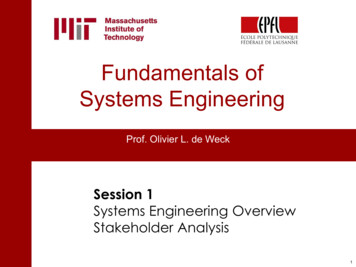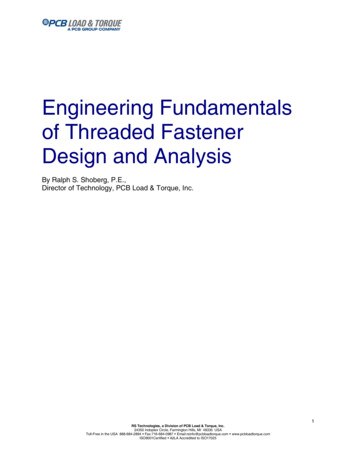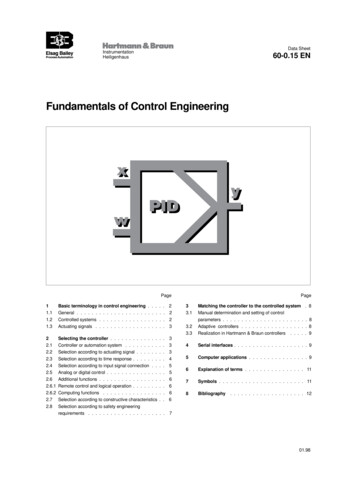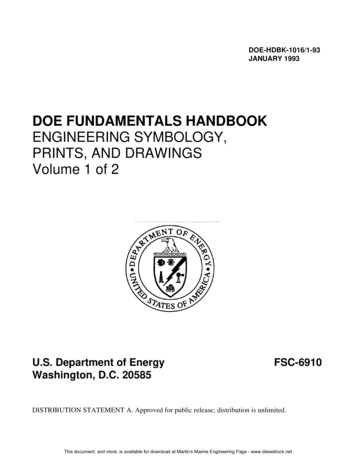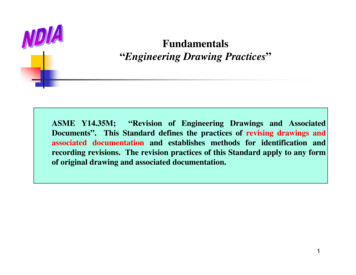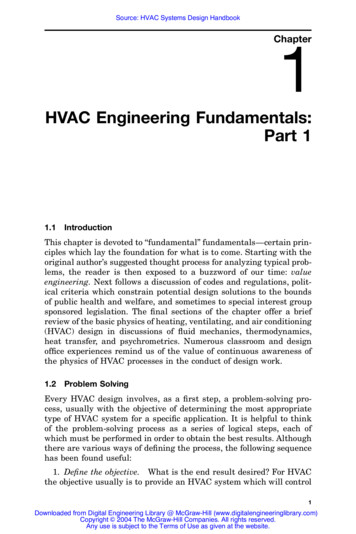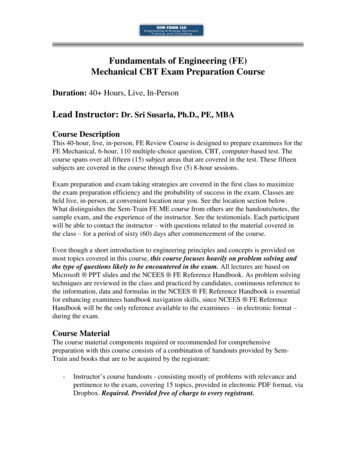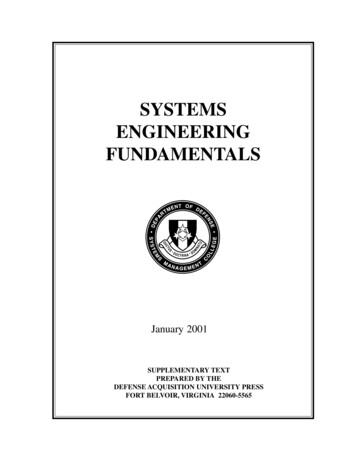
Transcription
IntroductionSystems Engineering FundamentalsSYSTEMSENGINEERINGFUNDAMENTALSJanuary 2001SUPPLEMENTARY TEXTPREPARED BY THEDEFENSE ACQUISITION UNIVERSITY PRESSFORT BELVOIR, VIRGINIA 22060-5565i
Systems Engineering FundamentalsIntroductionii
IntroductionSystems Engineering FundamentalsTABLE OFCONTENTSPREFACE . ivPART 1. INTRODUCTIONChapter 1.Introduction to Systems Engineering Management . 3Chapter 2.Systems Engineering Management in DoD Acquisition . 11PART 2. THE SYSTEMS ENGINEERING PROCESSChapter 3.Systems Engineering Process Overview . 31Chapter 4.Requirements Analysis . 35Chapter 5.Functional Analysis and Allocation . 45Chapter 6.Design Synthesis . 57Chapter 7.Verification . 65Chapter 8.Systems Engineering Process Outputs . 73PART 3. SYSTEM ANALYSIS AND CONTROLChapter 9.Work Breakdown Structure . 85Chapter 10. Configuration Management . 91Chapter 11. Technical Reviews and Audits . 99Chapter 12. Trade Studies . 111Chapter 13. Modeling and Simulation . 117Chapter 14. Metrics . 125Chapter 15. Risk Management . 133PART 4. PLANNING, ORGANIZING, AND MANAGINGChapter 16. Systems Engineering Planning . 147Chapter 17. Product Improvement Strategies . 157Chapter 18. Organizing and Integrating System Development . 171Chapter 19. Contractual Considerations . 185Chapter 20. Management Considerations and Summary . 201GLOSSARY . 209iii
Systems Engineering FundamentalsIntroductionPREFACEThis book provides a basic, conceptual-level description of engineering management disciplines thatrelate to the development and life cycle management of a system. For the non-engineer it provides anoverview of how a system is developed. For the engineer and project manager it provides a basic frameworkfor planning and assessing system development.Information in the book is from various sources, but a good portion is taken from lecture material developed for the two Systems Planning, Research, Development, and Engineering courses offered by theDefense Acquisition University.The book is divided into four parts: Introduction; Systems Engineering Process; Systems Analysis andControl; and Planning, Organizing, and Managing. The first part introduces the basic concepts thatgovern the systems engineering process and how those concepts fit the Department of Defense acquisitionprocess. Chapter 1 establishes the basic concept and introduces terms that will be used throughout thebook. The second chapter goes through a typical acquisition life cycle showing how systems engineeringsupports acquisition decision making.The second part introduces the systems engineering problem-solving process, and discusses in basicterms some traditional techniques used in the process. An overview is given, and then the process ofrequirements analysis, functional analysis and allocation, design synthesis, and verification is explainedin some detail. This part ends with a discussion of the documentation developed as the finished output ofthe systems engineering process.Part three discusses analysis and control tools that provide balance to the process. Key activities (such asrisk management, configuration management, and trade studies) that support and run parallel to thesystem engineering process are identified and explained.Part four discusses issues integral to the conduct of a systems engineering effort, from planning toconsideration of broader management issues.In some chapters supplementary sections provide related material that shows common techniques orpolicy-driven processes. These expand the basic conceptual discussion, but give the student a clearerpicture of what systems engineering means in a real acquisition environment.iv
Chapter 1Introduction to Systems EngineeringPART 1INTRODUCTION1
Systems Engineering FundamentalsChapter 12
Chapter 1Introduction to Systems EngineeringCHAPTER 1INTRODUCTION TOSYSTEMS ENGINEERINGMANAGEMENT1.1 PURPOSE499A, Engineering Management, 1 May 1974.Now cancelled.)The overall organization of this text is describedin the Preface. This chapter establishes some ofthe basic premises that are expanded throughoutthe book. Basic terms explained in this chapter arethe foundation for following definitions. Key systems engineering ideas and viewpoints are presented, starting with a definition of a system. An interdisciplinary approach that encompassesthe entire technical effort, and evolves into andverifies an integrated and life cycle balancedset of system people, products, and process solutions that satisfy customer needs. (EIA StandardIS-632, Systems Engineering, December 1994.) An interdisciplinary, collaborative approach thatderives, evolves, and verifies a life-cycle balanced system solution which satisfies customerexpectations and meets public acceptability.(IEEE P1220, Standard for Application andManagement of the Systems EngineeringProcess, [Final Draft], 26 September 1994.)1.2 DEFINITIONSA System Is Simply stated, a system is an integrated compositeof people, products, and processes that provide acapability to satisfy a stated need or objective.In summary, systems engineering is an interdisciplinary engineering management process thatevolves and verifies an integrated, life-cycle balanced set of system solutions that satisfy customerneeds.Systems Engineering Is Systems engineering consists of two significantdisciplines: the technical knowledge domain inwhich the systems engineer operates, and systemsengineering management. This book focuses onthe process of systems engineering management.Systems Engineering Management Is As illustrated by Figure 1-1, systems engineeringmanagement is accomplished by integrating threemajor activities:Three commonly used definitions of systemsengineering are provided by the best known technical standards that apply to this subject. They allhave a common theme: Development phasing that controls the designprocess and provides baselines that coordinatedesign efforts, A logical sequence of activities and decisionsthat transforms an operational need into a description of system performance parameters anda preferred system configuration. (MIL-STD- A systems engineering process that providesa structure for solving design problems and3
Systems Engineering FundamentalsChapter fe CyclePlanningLife CycleIntegrationFigure 1-1. Three Activities of Systems Engineering ManagementThe systems engineering process is the heart ofsystems engineering management. Its purpose isto provide a structured but flexible process thattransforms requirements into specifications, architectures, and configuration baselines. The discipline of this process provides the control and traceability to develop solutions that meet customerneeds. The systems engineering process may berepeated one or more times during any phase ofthe development process.tracking requirements flow through the designeffort, and Life cycle integration that involves customersin the design process and ensures that the systemdeveloped is viable throughout its life.Each one of these activities is necessary to achieveproper management of a development effort. Phasing has two major purposes: it controls the designeffort and is the major connection between the technical management effort and the overall acquisition effort. It controls the design effort by developing design baselines that govern each level ofdevelopment. It interfaces with acquisition management by providing key events in the development process, where design viability can be assessed. The viability of the baselines developed isa major input for acquisition management Milestone (MS) decisions. As a result, the timing andcoordination between technical developmentphasing and the acquisition schedule is critical tomaintain a healthy acquisition program.Life cycle integration is necessary to ensure thatthe design solution is viable throughout the life ofthe system. It includes the planning associated withproduct and process development, as well as theintegration of multiple functional concerns into thedesign and engineering process. In this manner,product cycle-times can be reduced, and the needfor redesign and rework substantially reduced.1.3 DEVELOPMENT PHASINGDevelopment usually progresses through distinctlevels or stages:4
Chapter 1Introduction to Systems Engineeringdescriptions, and the product baseline for the subsystem/component detail descriptions. Figure 1-2shows the basic relationships between the baselines.The triangles represent baseline control decisionpoints, and are usually referred to as technical reviews or audits. Concept level, which produces a system conceptdescription (usually described in a conceptstudy); System level, which produces a system description in performance requirement terms; andLevels of Development Considerations Subsystem/Component level, which producesfirst a set of subsystem and component productperformance descriptions, then a set ofcorresponding detailed descriptions of theproducts’ characteristics, essential for theirproduction.Significant development at any given level in thesystem hierarchy should not occur until the configuration baselines at the higher levels are considered complete, stable, and controlled. Reviewsand audits are used to ensure that the baselines areready for the next level of development. As will beshown in the next chapter, this review and auditprocess also provides the necessary assessment ofsystem maturity, which supports the DoDMilestone decision process.The systems engineering process is applied to eachlevel of system development, one level at a time,to produce these descriptions commonly calledconfiguration baselines. This results in a series ofconfiguration baselines, one at each developmentlevel. These baselines become more detailed witheach level.1.4 THE SYSTEMS ENGINEERINGPROCESSIn the Department of Defense (DoD) the configuration baselines are called the functional baselinefor the system-level description, the allocatedbaseline for the subsystem/ component performanceThe systems engineering process is a top-downcomprehensive, iterative and recursive problemConcept StudiesDESIGN DEFINITIONSystem Definiiton(Functional Baseline)DESIGN DEFINITIONDESIGN DEFINITIONFigure 1-2. Development Phasing5Preliminary Design(Allocated Baseline)Detail Design(Product Baseline)
Systems Engineering FundamentalsChapter 1solving process, applied sequentially through allstages of development, that is used to:During the systems engineering process architectures are generated to better describe and understand the system. The word “architecture” is usedin various contexts in the general field of engineering. It is used as a general description of howthe subsystems join together to form the system. Itcan also be a detailed description of an aspect of asystem: for example, the Operational, System, andTechnical Architectures used in Command, Control, Communications, Computers, Intelligence,Surveillance, and Reconnaissance (C4ISR), andsoftware intensive developments. However, Systems Engineering Management as developed inDoD recognizes three universally usable architectures that describe important aspects of the system:functional, physical, and system architectures. Thisbook will focus on these architectures as necessary components of the systems engineeringprocess. Transform needs and requirements into a set ofsystem product and process descriptions (adding value and more detail with each level ofdevelopment), Generate information for decision makers, and Provide input for the next level of development.As illustrated by Figure 1-3, the fundamental systems engineering activities are RequirementsAnalysis, Functional Analysis and Allocation, andDesign Synthesis—all balanced by techniques andtools collectively called System Analysis and Control. Systems engineering controls are used to trackdecisions and requirements, maintain technicalbaselines, manage interfaces, manage risks, trackcost and schedule, track technical performance,verify requirements are met, and review/audit theprogress.PROCESSINPUTThe Functional Architecture identifies and structures the allocated functional and performancerequirements. The Physical Architect
The second part introduces the systems engineering problem-solving process, and discusses in basic terms some traditional techniques used in the process. An overview is given, and then the process of requirements analysis, functional analysis and allocation, design synthesis, and verification is explained in some detail. This part ends with a .

